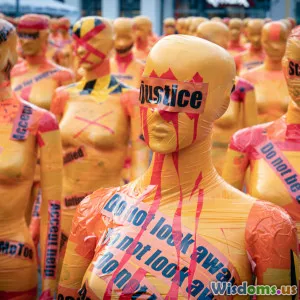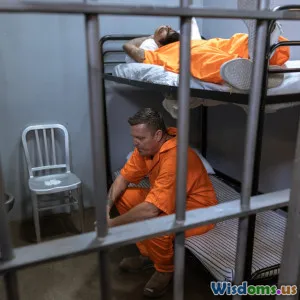
Comparing Open Prisons to Maximum Security Facilities Worldwide
13 min read A global comparison of open and maximum security prisons, exploring systems, effectiveness, human rights, and societal impact with data and real-world insights. (0 Reviews)
Comparing Open Prisons to Maximum Security Facilities Worldwide
Introduction: Behind Barbed Wire and Open Gates
What if you heard that, in some countries, prison inmates leave daily for work, share communal spaces, and even manage aspects of their daily schedules—while others are subject to intense surveillance, minimal human contact, and reinforced barriers? The way societies choose to incarcerate their citizens says volumes about their values, philosophies, and approach to justice. At the heart of this spectrum lie two radical models: open prisons and maximum security facilities. This article embarks on a detailed journey exploring these contrasting approaches, examining their effectiveness, ethical implications, and impact both inside and outside the walls.
The Anatomy of Different Prison Models
What is an Open Prison?
Open prisons, also called minimum security or 'open' correctional facilities, are shaped by principles remarkably different from traditional punitive incarceration. Here, fences are rare, mobility within and occasionally outside the facility is granted, and inmates are often entrusted with responsibilities that mirror daily life beyond prison.
Key Characteristics
- Low Security: Perimeter defences may be minimal or practically nonexistent.
- Autonomy: Inmates often manage much of their daily schedule, attend work or education outside the grounds, and engage in community activities.
- Focus on Rehabilitation: Programs are highly tailored towards reintegration and personal development.
Global Examples
- Norway: At Bastøy Prison, inmates live in cottages, work on the island, and participate in therapy sessions. Over 70% have jobs on or off the prison grounds.
- India: Open prisons like the Sanganer Open Prison allow inmates to live with their families and work regular jobs in nearby towns.
- United Kingdom: Over 3,500 inmates are held in open prisons, permitted to leave temporarily for work placements and training.
What Defines a Maximum Security Facility?
At the other end of the spectrum lies the maximum security prison: the archetype featured in countless movies and investigative reports, designed first and foremost for control and risk containment.
Key Characteristics
- High Security: Thick walls, razor wire, armed guards, CCTV at every angle; resources are invested in keeping inmates inside and risks managed.
- Strict Regimentation: Schedules are tightly controlled, movement is supervised, and human interaction can be minimal or heavily restricted.
- Segregation: Particularly dangerous or high-profile inmates may be isolated for most hours of the day.
Global Examples
- United States: The ADX Florence in Colorado is dubbed the "Alcatraz of the Rockies," housing terrorists and cartel leaders in isolation 23 hours a day.
- Russia: The notorious Black Dolphin Prison maintains constant surveillance and double iron doors, with inmates blindfolded during transport.
- Australia: Goulburn Correctional Centre’s “Supermax” facility applies the highest security measures for violent offenders.
Philosophies and Goals: Rehabilitation vs. Retribution
The Open Prison Ethos
Open prisons do not emerge by chance—they are products of deliberate ideology. Scandinavian models are based on "restorative justice," seeing incarceration not as retribution but as a societal obligation to rehabilitate.
Cecilie Høigård, a Norwegian criminologist, says, "Every inmate is a neighbor, a future co-worker—they don’t stop being members of society."
Key aspects include:
- Belief in personal growth and change
- Preparation for a smooth transition to society
- Minimal use of punitive measures, prioritizing trust
The Maximum Security Paradigm
Maximum security is rooted in risk aversion and containment. Societies that employ this model typically prioritize public safety and retribution, arguing that severe criminals forfeit certain liberties for citizens’ protection.
John Pfaff, a leading American prison scholar, notes, “Maximum security exists not just for safety, but as an expression of society’s fear and desire for retribution.”
These facilities target:
- Neutralizing escape or violence risks
- Isolating individuals believed to threaten public order initially and upon release
- Enforcing strict discipline as both deterrence and punishment
Practical Realities: Living Inside Each System
Inmate Experiences
Open Prisons
Life mirrors aspects of the outside world:
- Responsibility: Inmates may work in agriculture, factories, or community service—building experience and trust.
- Autonomy: The ability to cook, clean, and make day-to-day decisions fosters self-sufficiency.
- Community: There’s a strong culture emphasizing mutual respect, personally accountable behavior, and participatory governance.
For example, prisoners at Bastøy talk of “finding humanity again.” Recidivism, or reoffending rates, hover under 20% for those released from these institutions—compared to well over 50% in most traditional systems (Norwegian Ministry of Justice).
Maximum Security Environments
Here, daily life may involve:
- Extreme Supervision: Inmates are escorted by guards even in solitary exercise enclosures. Contact is heavily restricted, and environmental stimuli are minimized.
- Limited Privileges: Basic activities like phone calls, visits, and recreation are governed by rigid regulations.
- Emphasis on Discipline: Noncompliance leads to solitary confinement or privilege loss.
A former ADX Florence inmate recounted to The Marshall Project: “You’re alone with your thoughts for 23 hours, every day. It’s not just confinement. It’s erasure.”
Recidivism rates in the U.S. can run as high as 76% within five years of release, according to Bureau of Justice statistics—a sharp contrast to the Scandinavian models.
Staff and Security
- Open Prisons: Staff serve as mentors and facilitators as much as security, monitoring well-being and guiding reintegration.
- Maximum Security: Staff must balance strict discipline with vigilance against violence, escape, and contraband—a constant battle with high stress and burnout rates.
Societal Impact and Outcomes
Rehabilitation and Recidivism
Perhaps the most discussed outcome is recidivism.
Norway: Open system recidivism is about 20%. United States: Maximum security facilities see recidivism rates exceeding 60% (for all security levels combined). India: Rajasthan open prison project reported a mere 14% reoffending rate (Commonwealth Human Rights Initiative).
Public Perception
Open prisons are sometimes lambasted as “country clubs for criminals.” Yet societies with effective open systems (like Norway, Sweden, and the Netherlands) demonstrate less public fear, more confidence in rehabilitation, and lower incarceration rates overall compared to countries relying on more punitive models.
Cost Effectiveness
Maximum security prisons rank among the world’s most expensive facilities:
- AD Florence (USA): Estimated cost exceeds $60,000 per inmate annually.
- Open Prison (Norway): Average cost is about $90 per day, with reduced downstream costs thanks to lower recidivism.
- India’s Open Prisons: Run at a fraction of the cost due to fewer guards and infrastructure needs.
Challenges Each Model Faces
Open Prisons: Risks and Criticisms
- Potential for Absconding: Critics worry about prisoners escaping or returning to crime mid-sentence. However, data shows escapes are rare, typically under 1%, according to European Committee for the Prevention of Torture.
- Public Skepticism: Repeated incidents, when they occur, can spark outrage and threaten the model’s legitimacy.
- Suitability: Not all prisoners are eligible—violent or high-risk individuals are generally excluded.
Maximum Security: Human Rights and Social Cost
- Isolation and Mental Health: Extended solitary confinement has been linked to depression, anxiety, and psychosis. UN Rapporteur Juan Méndez called it "torture that should be prohibited except in very exceptional circumstances."
- Reintegration Barriers: Inmates re-entering society after years of isolation often struggle with basic interpersonal skills and independence.
- Financial Burden: The high costs associated with ‘supermax’ facilities stretch public budgets, with less return in reducing crime.
Innovations and Cross-Pollination
Some countries experiment with hybrids:
- Finland: Transition programs move prisoners stepwise from closed to open settings before release, combining safety with gradual reintegration.
- South Africa: ‘Halfway houses’ blend intensive support with monitored freedoms.
Progressive policies elsewhere suggest that elements such as community reintegration and robust mental health support can be adapted even within high-security contexts to improve outcomes.
Ethical and Philosophical Debates
Safety vs. Rehabilitation
Many debate, "What is prison for?" Proponents of open prisons argue that, beyond reducing recidivism, such systems reflect a society's capacity for mercy and belief in second chances.
On the other hand, victims’ advocacy groups warn that prematurely trusting offenders may put communities at risk. The solution, some argue, may lie not in choosing one model, but in precise, evidence-informed case assessment.
Human Rights Considerations
International organizations increasingly criticize extended solitary confinement and conditions found in some supermax facilities. The European Court of Human Rights and the United Nations issue rebukes and establish minimum standards for humane treatment—rarely a concern for developed open prison systems.
Future Trends: Shifting the Global Landscape
Social, political, and economic change continue to influence the debate.
- Prison Population Pressures: With incarceration rates at or near international highs, countries like the U.S., Brazil, and Russia face unsustainable prison budgets and crowding.
- Evidence-Based Reform: Nations are increasingly pressured to review recidivism data and innovate if high-security approaches aren’t delivering public safety efficiently.
- Restorative Initiatives: Grassroots and national movements for restorative justice are gaining traction, especially in Europe and Oceania, promoting models blending community involvement and reconciliation.
Conclusion: A Call for Nuanced Justice
The yawning gulf between open prisons and maximum security facilities is rooted less in architecture than in the hearts and priorities of the societies that build them. Open prisons sell hope: that most people, given tools and trust, can change. Maximum security practices, though crucial for society’s most dangerous, often entrench cycles of isolation that sap both inmates and societies.
As nations grapple with rising costs, human rights pressures, and the ongoing challenge of reducing crime long-term, the open versus maximum-security debate becomes more than academic. With lives, budgets, and futures at stake, the global prison conversation isn’t about picking one approach—it’s about asking, again and again, how much we are willing to believe in the power of change.
Rate the Post
User Reviews
Popular Posts

















